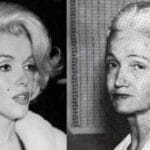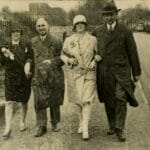We all recognize the name Elie Wiesel – a man whose story of survival during the Holocaust resonated deeply with the world, a voice that gave expression to unimaginable pain. But his story, forever etched in our collective memory, isn’t the only one that emerged from the ashes of Auschwitz. This is the story of his sister, Beatrice – a woman who walked through the fire alongside him, carrying her own burden of grief and hope.
A Childhood Shattered: Beatrice’s Journey Begins
Beatrice’s life, like her brother’s, began in the peaceful town of Sighet, Romania. Imagine a close-knit family, the warmth of shared meals, the comfort of familiar streets – all shattered by the encroaching darkness of Nazi occupation. Torn from their home, Beatrice, Elie, and their sister Hilda were thrust into the horrors of Auschwitz, a place where humanity itself seemed to vanish.
Finding Strength in Sisterhood: Inside the Walls of Auschwitz
Imagine clinging to your sibling in the freezing barracks, the stench of fear and death clinging to everything. Beatrice and Hilda, united by their shared experience, leaned on each other for strength. Their bond, forged in the fires of unspeakable suffering, became a lifeline in a sea of despair.
A Glimmer of Hope: Reunion and the Long Road to Healing
After liberation, fate reunited Beatrice and Hilda with their brother Elie in a French orphanage. Think of the bittersweet joy of that reunion – the relief of finding each other, the gaping hole left by the loved ones they’d lost. The trauma of their past cast a long shadow, but their spirits, though wounded, were not broken. They were determined to rebuild their lives, piece by fragile piece.
Beatrice eventually made her way to North America, seeking a fresh start, a chance at normalcy in a world that felt anything but normal. It probably wasn’t easy to leave her brother, but the desire for a brighter future likely spurred her on. She found solace in the simple joys of life – the comfort of family, the warmth of community. She built a life, brick by brick, on the foundation of resilience forged in the crucible of Auschwitz.
Beatrice’s story isn’t just about survival; it’s about the extraordinary resilience of the human spirit. It’s a testament to the power of family, the enduring strength we find in each other when the world seems determined to tear us apart. It reminds us that even in the face of unimaginable darkness, the human heart still yearns for light, for connection, for the chance to laugh and love again. Beatrice Wiesel’s life, lived quietly in the shadow of her brother’s fame, carries a powerful message – one of hope, of courage, and the unwavering belief in the possibility of finding joy even amidst the ruins.
Unlocking the Fate of Beatrice and Hilda Wiesel: An SEO Deep Dive
While Elie Wiesel’s harrowing account in “Night” brought their family’s story to light, the experiences of his sisters, Beatrice and Hilda, offer a unique and often overlooked perspective on survival and the Holocaust’s enduring impact. Against all odds, Elie Wiesel’s sisters, Beatrice and Hilda, emerged from the horrors of Auschwitz, rebuilding their lives and reuniting with their brother in a testament to resilience and the enduring bonds of family.
Here’s a closer look at what we know about their journey:
I. Early Life and Family:
- Origin: Eliezer Wiesel, along with his sisters Hilda and Beatrice, were born in Sighet, Maramureș (now part of Romania).
- Multilingual Upbringing: The Wiesel family communicated in Yiddish, German, Hungarian, and Romanian.
- Parents: Their parents were Sarah Feig and Shlomo Wiesel.
- Family Business: Hilda and Beatrice assisted in the family’s grocery store.
II. The Holocaust and Separation:
- Deportation: The Wiesel family was deported by the Nazis in 1944.
- Auschwitz: The family was separated upon arrival at Auschwitz. Tragically, Elie’s mother, Sarah, and younger sister, Tzipora, perished in the camp.
- Survival: Despite the horrors they faced, Beatrice and Hilda survived their imprisonment in Auschwitz.
III. Reunion and Life After Auschwitz:
- Reunion in France: Reunited in a French orphanage after the war, Beatrice and Hilda Wiesel navigated a world forever changed, their lives forever marked by the absence of their parents and younger sister, Tzipora.
- Beatrice’s Journey: She had believed Elie to be dead and had gotten engaged, moving to France. They reunited almost a year later in Antwerp, Belgium.
- Hilda’s Whereabouts: Details about Hilda’s whereabouts after the war and before the reunion are unclear, providing an avenue for further research.
- Immigration to North America: Ultimately, Beatrice and Hilda immigrated to North America, further details on their lives there remain largely unchronicled.
IV. Public Awareness and Legacy:
- Elie’s Account: Elie Wiesel’s renowned memoir, “Night,” sheds light on their shared experience in the Holocaust, primarily from his perspective.
- Limited Information: Details about Beatrice and Hilda’s post-war lives remain relatively scarce, overshadowed by Elie’s prominence as a writer and activist.
Beatrice and Hilda Wiesel’s lives after Auschwitz stand as a powerful reminder that even amidst unimaginable loss, the human spirit can persevere, finding solace in family and hope in a new tomorrow.
Analyzing Beatrice Wiesel in “Night”
While “Night” focuses on Eliezer and his father, it offers a heartbreaking glimpse into the fate of his mother and youngest sister, Tzipora. Beatrice, Eliezer’s eldest sister, survived Auschwitz along with her other sister, Hilda. While “Night” is a powerful testament to Elie’s experience, Beatrice Wiesel’s story is not directly told within its pages. To uncover her life, we must look beyond the memoir to historical records and the experiences of other survivors.
The silence surrounding Beatrice in “Night” reflects a broader reality – the experiences of many female Holocaust victims remain underrepresented in literature. However, Beatrice Wiesel, reunited with Eliezer after the war, serves as a testament to the enduring bonds of family amidst unimaginable tragedy.
Here’s what we can piece together about her life:
- Family Background: Beatrice “Béa” Wiesel was the eldest child of Shlomo and Sarah Wiesel. She had two younger sisters, Hilda and Tzipora, and a younger brother, Eliezer.
- Deportation and Survival: Beatrice, Hilda, and their mother were separated from Eliezer and their father upon arrival at Auschwitz. The sisters endured forced labor and the horrors of the camp.
- Reunion: Beatrice and Hilda survived Auschwitz and were reunited with Eliezer after liberation. Sadly, their parents and younger sister Tzipora perished in the Holocaust.
- Life After the War: Information about Beatrice’s life after the war is limited. We know she immigrated to North America, likely to Canada, with her sister Hilda.
When was Beatrice Wiesel Born?
Unfortunately, the exact date of Beatrice Wiesel’s birth remains a mystery. While we know quite a bit about the life of Elie Wiesel, the celebrated writer and Holocaust survivor, information about his siblings is harder to come by. It’s important to remember that behind every historical event, there are countless individual stories waiting to be uncovered. Beatrice Wiesel’s life, although the exact dates may be lost to time, is a powerful reminder of the human cost of intolerance and the importance of preserving the memories of those who endured such unimaginable circumstances.
- Crypto Quotes’ Red Flags: Avoid Costly Mistakes - June 30, 2025
- Unlock Inspirational Crypto Quotes: Future Predictions - June 30, 2025
- Famous Bitcoin Quotes: A Deep Dive into Crypto’s History - June 30, 2025















